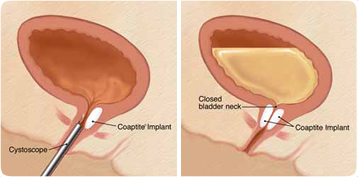Intrinsic Sphincter Deficiency (ISD) and Stress Incontinence
Intrinsic Sphincter Deficiency (ISD) occurs when there is weakness of the urethral sphincter. ISD may be caused by genetics, nerve damage from prior surgery, or neurological disorders. Urinary leakage typically occurs more frequently and in greater volumes in cases of ISD than in cases of stress urinary incontinence without ISD. The mid-urethral sling is the mainstay of treatment for ISD.
Treatment may also include injection with a periurethral bulking agent. The urethral bulking agent is injected into the tissue around the urethra during urethroscopy, where an instrument called a urethroscope is used to visualize the inside for the urethra. This is typically done in an outpatient setting while the patient is under anesthesia. The procedure takes 15-20 minutes. Recovery time is typically 1-2 days.
Initially, collagen was used as the bulking agent. Coaptite and Durasphere are newer bulking implants that last longer and maintain durability over time. Coaptite combines calcium hydroxylapatite particles and a sodium carboxymethylcellulose carrier gel to form a scaffold that promotes tissue infiltration around the urethra to strengthen the urethra and decrease the urinary leakage associated with ISD. Durasphere EXP is composed of pyrolytic carbon coated beads suspended in a carrier gel made up of 97% water and 3% beta glucan. Beta glucan initiates a subtle inflammatory response which will scar in the area to stiffen and strengthen the urethra and provides wound healing properties.
If you are struggling with Intrinsic Sphincter Deficiency and/or Urinary Incontinence, you can learn more about the conditions by reading our blogs about incontinence as well as schedule a free consultation by contacting Austin Urogynecology today.
The Lowdown: Urge vs. Stress Incontinence
Got questions? Need an appointment? We’re here to help!
